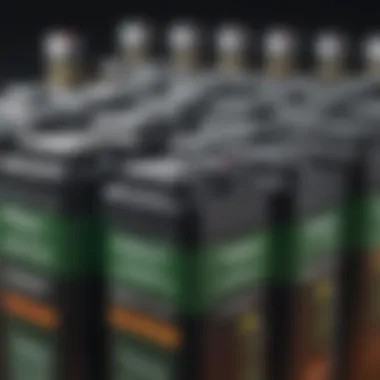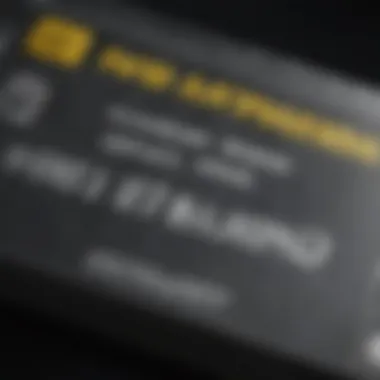Comprehensive Guide to Flowzone Battery Replacement


Intro
Key Concepts and Terminology
Basic Definitions
To begin, it is critical to understand a few key terms related to Flowzone batteries. The term "battery" refers to a device that stores energy for use. In the context of Flowzone sprayers, the most common battery types include lithium-ion and lead-acid. Lithium-ion batteries are known for their lightweight design and high energy density, making them suitable for many sprayer models. Lead-acid batteries, while heavier, may still be used in various applications due to their cost-effectiveness.
Historical Context
The evolution of battery technology has significantly influenced agricultural practices. Historically, farmers relied on manual methods or basic machinery powered by gasoline engines. With advancements in battery technology, tools like Flowzone sprayers have emerged, offering greater efficiency and ease of use. Understanding the historical development of batteries in agriculture helps appreciate the current trends and innovations in this field.
Recent Innovations and Trends
Technological Advancements
Recent innovations in battery technology continue to enhance the performance and usability of Flowzone sprayers. For example, improvements in lithium-ion technology have resulted in longer-lasting batteries that require less frequent replacements. Additionally, smart battery management systems are being developed. These systems monitor battery health and usage, predicting when a replacement is necessary, and ensuring optimal performance.
Sustainable Practices
Sustainability is also a growing focus in battery technology. Many manufacturers are now prioritizing environmentally friendly materials and production processes. For instance, recycling programs for used batteries are becoming more common, reducing the ecological impact of battery disposal. Embracing sustainability not only benefits the environment but also improves the reputation of agricultural practices.
Practical Applications and Techniques
Step-by-step Guides
Replacing a Flowzone battery involves several steps. Start by gathering necessary tools, such as a screwdriver and safety gloves. After ensuring the sprayer is off, locate the battery compartment and remove any screws. Carefully disconnect the old battery, noting the connections. Install the new battery by reversing the removal process. Finally, secure everything and test the sprayer to confirm proper operation.
Case Studies
Several case studies illustrate the importance of routine battery maintenance. For example, a farmer reported increased operational efficiency after routinely checking battery health and replacing old batteries. Another case showed a professional who avoided costly downtime by promptly addressing battery issues identified through smart management systems. These real-world examples emphasize the significance of understanding battery maintenance.
"Regular battery maintenance is key to maximizing the lifespan and effectiveness of sprayers."
Prelude to Flowzone Technology
Flowzone technology represents a significant evolution in the design and functionality of sprayers, particularly in agricultural applications. Understanding this technology is crucial for effective and efficient sprayer use. This section delves into the specifics of Flowzone's approach to sprayer design, focusing on the advantages this technology offers to users, such as improved performance, ease of use, and enhanced battery life. The implementation of Flowzone technology not only maximizes operational efficiency but also impacts the overall productivity of agricultural tasks.
Overview of Flowzone Sprayers
Flowzone sprayers are designed for both professional and amateur users, providing versatility in various applications. These sprayers come equipped with advanced features that cater to different spraying needs.
- User-Friendly Design: Flowzone sprayers boast intuitive controls that simplify the spraying process.
- Durability: Constructed with robust materials, these sprayers are built to withstand harsh environments in the field.
- Variety of Models: There are various models available, each tailored to specific requirements, from hobby gardening to large-scale farm operations.
In addition to the core functionality, Flowzone sprayers often integrate smart technology, allowing users to monitor performance and battery status efficiently.
Importance of Battery Power in Sprayers
Battery power is an essential element in the operation of Flowzone sprayers. The reliance on batteries leads to several advantages,
- Mobility: Being battery-operated means that Flowzone sprayers can be used in remote areas without access to power outlets.
- Efficiency: A strong battery ensures longer operation periods, thereby increasing productivity in the field.
- Versatility: Users can perform various tasks without the limitations posed by cords or lack of electrical outlets.


"Effective battery management is key to optimizing the functionality of Flowzone sprayers."
Battery performance directly affects not only the duration of usage but also the efficiency of the spraying process. Understanding how battery power influences the operation of Flowzone sprayers is vital for maintaining their effectiveness and longevity. Proper battery care will enhance the efficiency of the sprayers, making them an invaluable tool for agricultural practices.
Battery Types in Flowzone Products
In the realm of Flowzone products, understanding the different types of batteries is crucial. The battery not only serves as the power source but also impacts performance, longevity, and efficiency of the sprayer. Choosing the right battery type ensures that users can achieve optimal operation whether they are hobbyists or professional farmers.
Specifications of Flowzone Batteries
Flowzone employs specialized battery technology to enhance the functionality of their sprayers. The key specifications typically include capacity, voltage, and weight. For instance, Flowzone batteries often feature a capacity of around 20Ah to 40Ah, depending on the model. This measurement indicates how long the battery can provide power before needing a charge.
Voltage is another important specification. Most Flowzone sprayers use batteries with a nominal voltage of 24V. This provides the necessary power to efficiently operate the sprayers while ensuring compatibility across various models. Weight is equally significant as it affects the ease of handling. Flowzone batteries are designed to be lightweight yet robust enough to withstand regular use in diverse agricultural settings.
Comparing Lithium-Ion and Lead-Acid Batteries
When selecting a battery for Flowzone products, understanding the differences between Lithium-Ion and Lead-Acid batteries is essential.
- Lithium-Ion Batteries
- Lead-Acid Batteries
- Advantages: High energy density, longer cycle lifespan (typically up to 2000 cycles), and lightweight. This makes them suitable for extended use without frequent replacements.
- Disadvantages: Usually more expensive upfront, which could be a consideration for budget-conscious users.
- Advantages: Generally more cost-effective at the initial purchase. They also provide good performance in scenarios where heavy power is needed for short durations.
- Disadvantages: Heavier and bulkier, with a limited cycle lifespan (approximately 500 cycles). This can lead to more frequent replacements, ultimately increasing lifetime costs.
"Choosing the right battery type not only affects performance but also impacts the overall efficiency of operation."
It is advisable to consider the specific demands of your operations and balance cost with performance to make an informed decision.
Signs of Battery Failure
Recognizing signs of battery failure in Flowzone sprayers is crucial for maintaining optimal performance. A failing battery can result in ineffective spraying, impacting agricultural tasks considerably. Knowing when a battery is failing helps users take timely action, preventing obstacles in work efficiency and ensuring the sprayer operates to its full potential.
Decreased Runtime and Performance
When the runtime of a Flowzone sprayer noticeably decreases, it often signifies a problem with the battery. Users may find that the sprayer can no longer sustain the same use duration compared to previous sessions. If a full charge only yields a fraction of expected operating time, it is likely time for a replacement.
Poor performance might also manifest as intermittent power loss or a drop in delivery pressure, causing uneven spray patterns. Such issues highlight that the energy supply is insufficient for current demands. Monitoring these changes is key. Regular evaluations can help users spot these trends early and adapt their maintenance strategies accordingly.
Physical Markers of Battery Wear
Physical signs on a Flowzone battery can provide telltale indicators of its condition. Users should routinely inspect the battery for any swelling, cracks, or corrosion around terminals. These visual markers are signs that the battery may be reaching the end of its life cycle.
In addition, leaks can occur with certain battery types, which not only affect performance but can also present safety hazards. Recognizing these signs early allows users to act before further damage occurs, whether to the battery itself or the device.
Remember: Regular inspections and maintenance can prolong the life of your batteries and ensure that your Flowzone sprayer operates at peak efficiency.
Guidelines for Battery Replacement
When it comes to maintaining the efficiency of your Flowzone sprayers, understanding when and how to replace the battery is crucial. These guidelines serve as the foundation of effective battery management, allowing users to extend the life of their equipment while ensuring optimal performance. Whether you are a hobbyist or a professional in the agriculture field, knowing the precise steps to take in battery replacement can save time and expenses in the long run.
When to Replace Your Flowzone Battery
A Flowzone battery should be replaced when its performance noticeably declines. Key indicators include reduced runtime and consistent failure to hold a charge, which can disrupt your work, leading to inefficiency. Recognizing these signs early can help avoid situations where you might be left with inadequate power during crucial tasks. Moreover, when physical markers of wear appear, such as bulges or leaks, it's time to take action to prevent potential hazards.


Step-by-Step Replacement Procedure
Safety Precautions
Safety during battery replacement is paramount. It encompasses all preventive measures that ensure you avoid electrical shocks and injuries. Wearing gloves and protective eyewear is essential, as batteries can pose physical and chemical hazards. Disconnecting the battery from the sprayer before starting any procedure is a fundamental safety practice. This minimizes the risk of accidental activation during the replacement, ensuring you can work without undue stress about potential accidents.
Tools Required
To effectively replace a Flowzone battery, certain tools are vital. These typically include a screwdriver, a wrench, and in some cases, a specialized battery puller. Using the right tools ensures that you do not damage the sprayer's components, which can lead to additional repair costs. Each tool serves a specific function, making the process smoother and more efficient. It's beneficial to have everything prepared before starting to prevent interruptions in your workflow.
Disassembly Process
Disassembling the sprayer properly is a crucial step in the battery replacement procedure. Begin by removing any covers or panels that shield the battery compartment, usually secured with screws. Following the manufacturer’s guidelines for disassembly is important to avoid breaking clips or other integral parts. The disassembly process enables you to access the old battery safely and inspect surrounding components for potential issues.
Installing the New Battery
Installing the new battery correctly is vital for your sprayer's performance. Ensure the battery terminals align properly with the connectors in the sprayer; improper installation can lead to poor connectivity or damage to the battery itself. Once positioned, secure the battery firmly to prevent movement during operation. By adhering to correct procedures, you ensure that the new battery performs optimally from the start.
Reassembly and Testing
The final step of the replacement procedure involves reassembling the sprayer and testing the new battery. Take the time to ensure all covers are affixed tightly and that no tools are left inside the compartment. After reassembly, conduct a short test run. This confirms that everything is functioning well and that the battery has been installed correctly. Should any issues arise, they can be addressed immediately, rather than dealing with them later when the sprayer is in use.
Safety Considerations
Safety considerations are critical in the process of replacing Flowzone batteries. Understanding the potential risks associated with battery maintenance and replacement can prevent hazards, protect equipment, and ensure the longevity of the sprayer. Proper awareness of safety measures allows users to approach the task with confidence and care.
Understanding Battery Hazards
Batteries, particularly lithium-ion and lead-acid types, present certain hazards. If mishandled or damaged, these batteries can cause fires, leaks, or even explosions. Some common hazards include:
- Chemical Exposure: Batteries contain electrolytes which can be harmful if they come into contact with skin or eyes.
- Short Circuits: Inappropriate handling can lead to short circuits, creating a fire hazard.
- Physical Injury: Heavy batteries can cause physical strain during lifting and installation.
Awareness of these hazards can safeguard against serious harm, making it essential to observe safety protocols closely. Always wear protective gear, including gloves and goggles, when working with batteries. Do not forget to work in a well-ventilated area to avoid inhaling harmful gases that may be emitted during battery handling.
"Taking precautions when dealing with battery replacement is as vital as ensuring proper functioning of your equipment."
Proper Disposal of Old Batteries
Disposing of old batteries poses its own challenges and risks. Batteries contain substances that can be hazardous to the environment if not discarded correctly. Here are some essential points to ensure responsible disposal:
- Check Local Regulations: Different regions have specific rules regarding battery disposal. It is important to follow local guidelines to prevent legal issues and protect the environment.
- Recycle Whenever Possible: Many recycling centers accept batteries for proper recycling. This action minimizes waste and reduces the chances of harmful materials ending up in landfills.
- Use Designated Collection Sites: Look for designated collection points for batteries. Many retail locations and community programs offer safe drop-off sites for old batteries.
By attending to these disposal methods, users ensure they handle their batteries in an environmentally friendly and safe manner. Remember to check if there are special instructions for disposal mentioned on the battery packaging as well.
By integrating these safety considerations into the battery replacement process, users can avoid potential hazards. This approach not only protects individual health but it also promotes responsible usage and disposal practices.
Common Mistakes in Battery Replacement
Battery replacement can seem straightforward, yet there are several common mistakes that users often make. Ignoring these can lead to performance issues, safety hazards, or even damage to the equipment. Understanding the nuances of battery replacement in Flowzone sprayers aids in ensuring not just a longer lifespan for the battery but also for the sprayer itself. It is essential to approach the replacement process with care and attention to detail, keeping in mind certain best practices.
Ignoring Manufacturer Recommendations
One of the most critical mistakes in battery replacement is disregarding the manufacturer's specifications. Each model of Flowzone sprayer has specific requirements regarding the type and size of the battery. Ignoring these recommendations can lead to several problems. Using a battery that does not meet the specifications can strain the electrical system of the sprayer, resulting in inefficiencies or, in the worst cases, total failure of the device.


Moreover, manufacturer guidelines often detail safety precautions and correct installation procedures. Overlooking these aspects not only puts the device at risk but could cause personal injury. Therefore, it is crucial to consult the product manual before making any replacements—this ensures proper compatibility and safety standards are adhered to.
Using Incorrect Battery Types
Another frequent pitfall is the choice of an incorrect battery type for the Flowzone products. Flowzone primarily utilizes two types of batteries: lithium-ion and lead-acid. Each type has its own advantages and limitations. For instance, lithium-ion batteries typically offer a longer life and faster charging times, while lead-acid options are often less expensive but may have shorter service lives.
Using a non-recommended battery can result in various issues. If a lead-acid battery is used in a system designed for lithium-ion, the device may not operate efficiently. Over time, this can damage the electronic components. Likewise, if the voltage ratings differ significantly, it can trigger overheating or even cause the battery to fail entirely. Being diligent in choosing the correct battery not only promotes optimal performance but also enhances the safety of the device in use.
Always refer to the Flowzone user manual for guidance on the correct battery type and specifications to avoid potential complications.
Alternatives to Traditional Replacement
Considering alternatives to traditional battery replacement is critical for enhancing efficiency and minimizing costs in your Flowzone operations. Traditional replacement involves removing the old battery and installing a new one. While this method is straightforward, it may not always be the best choice for cost-effectiveness or sustainability. Exploring alternatives can extend the life of existing batteries and optimize performance, making it essential for both hobbyists and professionals.
Upgrading Battery Technology
Upgrading battery technology presents several benefits. Newer battery types often feature enhanced energy density, meaning they can store more energy in the same amount of space. Lithium-ion batteries are a prime example, as they offer longer lifespans compared to earlier lead-acid options. This translates to less frequent replacements, which greatly benefits users.
Also, modern batteries may come with smart features such as built-in charging management systems, which help prevent overcharging and prolong battery life while ensuring optimal performance. The initial investment in newer technology can often be recouped through reduced replacement costs and better productivity over time. Users should assess compatibility with their existing Flowzone sprayers to ensure a seamless upgrade.
Battery Maintenance Tips to Extend Life
Maintaining batteries properly is crucial for maximizing their usability and longevity. Here are some effective tips to consider:
- Regularly clean battery terminals to prevent corrosion, which can impede performance.
- Store batteries in a cool, dry place. High temperatures can reduce battery life significantly.
- Avoid extreme discharge. Regularly recharging batteries before they reach a completely low state can help maintain health.
- Calibrate batteries periodically, especially if using smart technology. This ensures that the battery management system accurately reports charge levels and aids in efficiency.
Proper maintenance practices can extend battery lifespan significantly, reducing the frequency of replacements and saving costs over time.
Following these guidelines not only optimizes your battery's performance but also contributes to greater sustainability within agricultural practices. By focusing on alternative methods and approaching battery maintenance with intention, Flowzone users can enhance their operational efficiency.
Frequently Asked Questions
The section on Frequently Asked Questions serves a crucial purpose in this article. It addresses common concerns that users may have regarding their Flowzone batteries and sprayers. By providing clear answers to these questions, we can help users make informed decisions. This section not only enhances user satisfaction but also improves the overall usability of the information provided. Key elements include:
- Concise Information: Answers are kept brief yet informative to cater to the needs of busy farmers and enthusiasts.
- Real-World Applications: Users get practical insights based on scenarios they may encounter frequently in their agricultural activities.
- Clarity and Confidence: With direct answers to common queries, readers gain confidence in their ability to manage their Flowzone products effectively.
How Long Does a Flowzone Battery Last?
Flowzone batteries typically have a lifespan of 2 to 5 years, depending on usage patterns and maintenance practices. For example, a battery that is regularly used and charged properly will last longer than one that is frequently left discharged. Remember that environmental conditions also play a role; extreme temperatures can shorten battery life.
It is essential to monitor the performance of the battery. If you notice a significant decrease in runtime or performance, it may indicate age or wear. Regular checks can help you stay ahead of potential issues, ensuring your sprayer operates efficiently.
Can Use My Flowzone Sprayer While Charging?
Using your Flowzone sprayer while it is charging is generally not recommended. Doing so can lead to overheating and potentially damage the battery. The charging process generates heat, and simultaneous use can further increase this temperature, putting your equipment at risk.
Should you need to use your sprayer urgently, it is advisable to wait until it is fully charged. This allows the battery to maintain its longevity and efficiency. Always refer to the manufacturer’s guidelines for the best practices specific to your model.
The End
In the realm of effective sprayer management, understanding battery replacement for Flowzone products holds significant importance. As outlined in this article, the functionality and longevity of the Flowzone sprayers are heavily reliant on the battery types used, their maintenance, and timely replacement. Battery management directly impacts performance and operational efficiency, essential for both casual users and professionals engaged in agricultural practices.
Summary of Key Points
- Battery Types: Flowzone utilizes specific battery types that must be considered when replacement is needed. Knowing the specifications and advantages of lithium-ion versus lead-acid batteries can influence the choice.
- Signs of Failure: Recognizing the symptoms of battery wear is crucial. Decreased runtime and physical markers, such as bulges or leaks, serve as indicators for replacement.
- Replacement Guidelines: Following precise replacement procedures is vital. This includes ensuring safety precautions, using the right tools, and adhering to the correct disassembly and reassembly processes.
- Safety Considerations: Properly understanding battery hazards and disposing of old batteries correctly helps mitigate negative environmental impacts and personal safety risks.
- Common Mistakes: Avoiding oversights in manufacturer recommendations and using incorrect battery types is critical for ensuring the sprayers’ longevity and efficiency.
- Alternatives and Maintenance: Exploring battery upgrades and implementing maintenance tips can extend battery life and enhance the efficiency of the Flowzone sprayer systems.
Final Thoughts on Battery Management
"Battery management is not an option; it is a necessity for maintaining the integrity and efficiency of your sprayer system."















